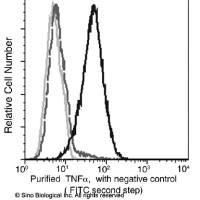RNAse A Treatment of Mouse Cells
互联网
Introduction
RNAse A treatment of permeabilized cells followed by immunostaining is a method which allows to show if the localization of a protein into the cell involves an RNAse-sensitive structure. This technique is highly dependent of the quality of the used RNAse A. In our lab, we used RNAse A treatment of mouse cells (see comment 1 ) to demonstrate that the enrichment in HP1 (Heterochromatin Protein 1) proteins at pericentric heterochromatin depends on the presence of an RNA component.
Back to top
Procedure
RNAse A preparation
RNAse A (from bovine pancreas) is an endoribonuclease that specifically cleaves single-stranted RNA. The enzyme attacks pyrimidine nucleotides at the 3'-phosphate group and cleaves the 5'-phosphate linkage to the adjacent nucleotide. RNAse A, which works in the absence of cofactors and divalent cations, can be inhibited by RNAse inhibitor.
The choice and the preparation of RNAse A is crucial for this protocol. RNAse A from some companies works perfectly for molecular biology applications but it can not be used for the cells, it simply kills them.
comment 2 ). The protocol below allows to obtain RNAse A that is free of Dnase.
- Dissolve RNAse A at a concentration of 10 mg/ml in 0.01M sodium acetate (pH 5.2);
- Heat to 100°C for 15 minutes;
- Allow to cool slowly to room temperature;
- Adjust the pH by adding 0.1 volumes of 1M TrisHCl (pH 7.4);
- Dispense into aliquots and store at -20°C.
Cell Extraction
In order to detect RNA-dependent proteins interactions in the cell nucleus, the cells have first to be extracted with detergent. This step allows the removal of soluble proteins while leaving more tightly bound proteins.
Grow adherent cells directly onto coverslips (see comment 3 )
- Wash with 1xPBS for 3 minutes at room temperature;
- Wash with CSK buffer for 3 minutes at room temperature (see comment 4 );
- Incubate in CSK buffer + 0.5% Triton X-100 for 5 minutes at room temperature (see comment 5 );
- Wash with CSK buffer for 3 minutes at room temperature;
- Wash twice with PBS for 3 minutes at room temperature.
RNAse A treatment
For RNAse A treatment on Triton X-100-permeabilized cells, titration experiments (RNAse concentration, time and temperature) have allowed to determine the following optimal conditions using RNAse A from Roche.
Obviously conditions have to be adjusted, depending not only on the RNAse but also on the cell type to be treated.
- Add 1mg/ml RNAse A in PBS for 10 minutes at room temperature;
- Wash twice with PBS for 3 minutes at room temperature;
- Fix in 2% paraformaldehyde in PBS for 15 minutes at room temperature (see comment 6 );
- Then carry out the immunostaining.
The specificity of RNAse A digestion has been monitored by following known RNA dependent markers like fibrillarin, a protein involved in ribosomal RNA maturation, which is dispersed after treatment. However, the nucleus is not totally screwed up as the staining of several nuclear components (nuclear membrane protein lamin B; splicing factors Sc-35; centromeric proteins CENP-A, B, and C) is preserved.
Back to top
Materials & Reagents
| CSK buffer |
Store in aliqots at -20°C
Before using add: 0.5mM PMSF, 10µg/ml leupeptin and 10µg/ml pepstatin |
Triton X-100 � Eurobio, GAUTTR00-01
Back to top
Reviewer Comments
Alessia Buscaino , Wellcome Trust (formerly of Akhtar Lab, EMBL).
- This protocol is also suitable for Drosophila SL-2 cells.
- I also agree that, the purity of the RNAse is crucial for the success of the experiment.
- SL-2 cells are grown on cover slips at a density of 7x106 cells/ml.
- All treatments with CSK buffer may be omitted.
- The permeabilization is performed in PBS containing 0.05% Triton X100, 0.05% Tween for 10 minutes. The incubation time with detergent and the concentration of both Tween and Triton are crucial for preserving the morphology of the cells. Each user should optimize these two parameters according to their personal experience.
- Cells are fixed in 3.7% formaldehyde for 10 minutes and washed 3 times for 10 minutes in PBS.
Back to top
Figures
Figure 1. An RNA-dependent structural epitope recognized by branched anti-methH3-K9 and anti-HP1 antibodies at pericentromeric regions. Triton X-100-permeabilized L929 cells were treated with RNAse A (+RNAse) or mock-treated (-RNAse) before paraformaldehyde fixation. Double-labeling immunofluorescence was carried out using anti-HP1 and branched anti-methH3-K9 antibodies. DNA was counterstained with DAPI. Scale bar=10µm.
Figure 2. Western blot of total proteins from Triton X-100-permeabilized L929 cells treated with RNAse A (+RNAse) or mock-treated (-RNAse) using the indicated antibodies.









